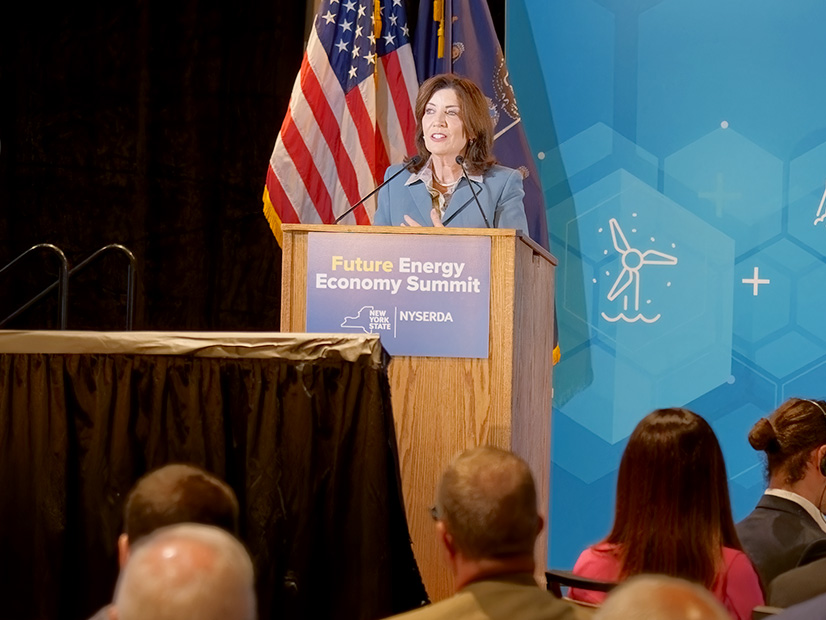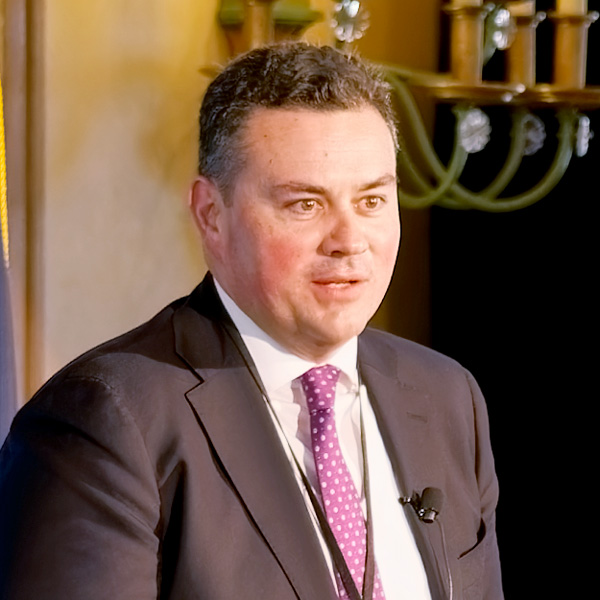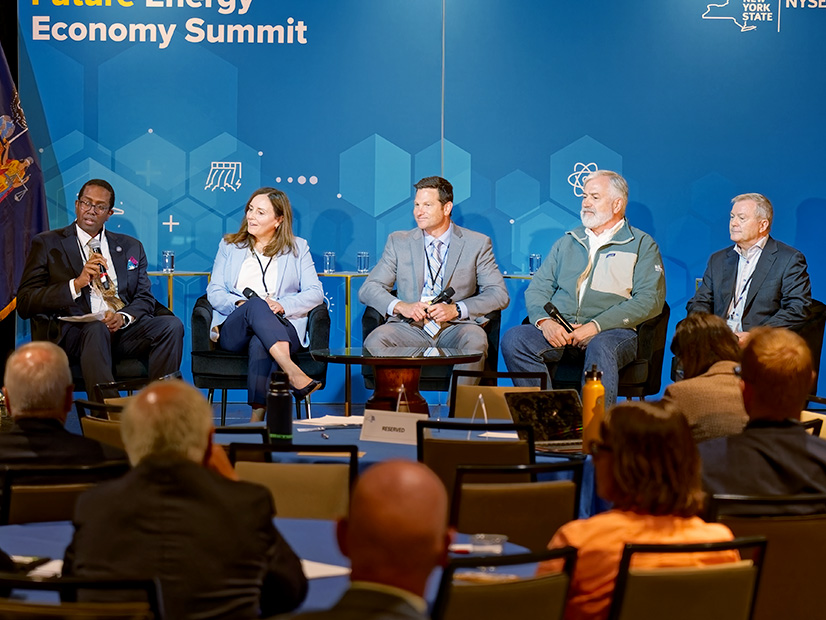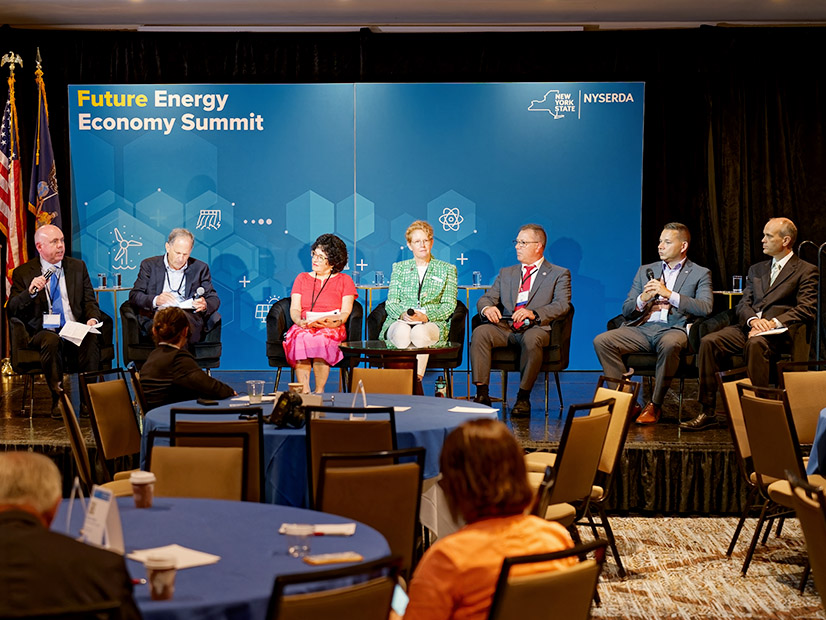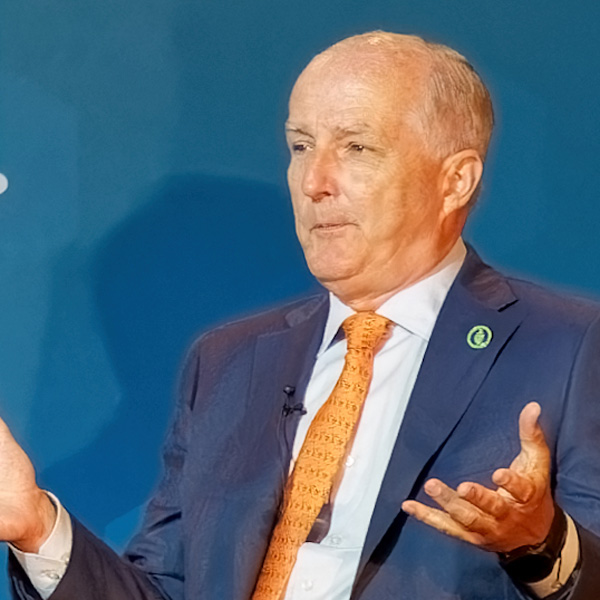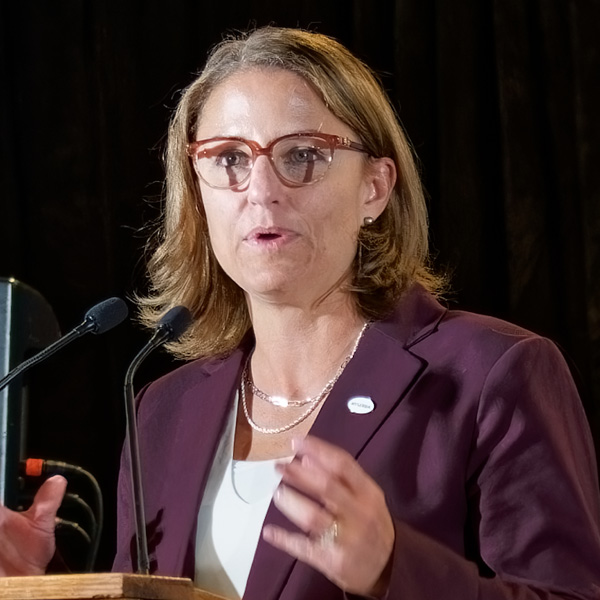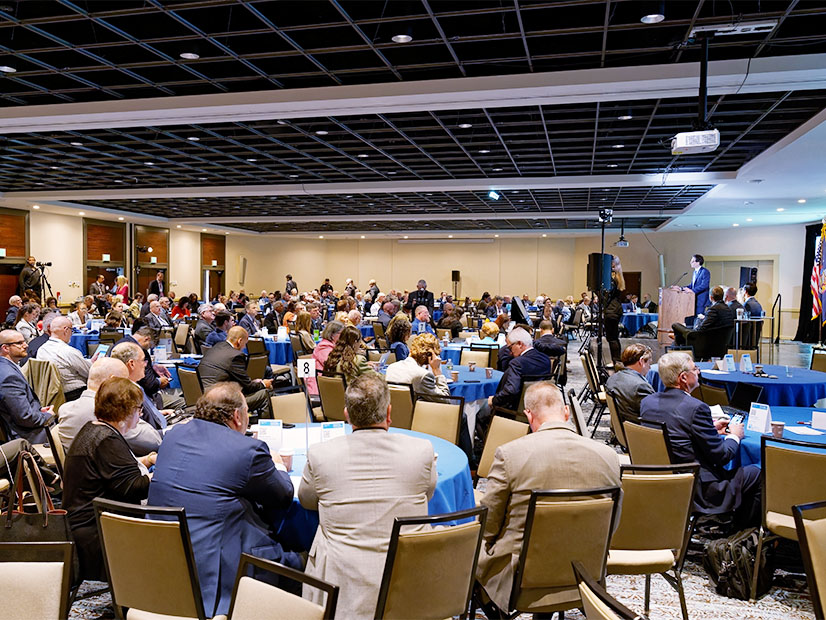
SYRACUSE — A summit convened to examine future energy technologies in New York and the economy that will grow around them gave outsized attention to one technology: nuclear power.
As the state’s efforts to site wind turbines and solar panels struggle with project delays, cancellations and cost increases, and as the federal government doubles down on support for next-generation nuclear, advanced reactors are getting a closer look.
The state issued a draft blueprint for considering advanced nuclear during the summit, and it populated panel discussions with nuclear proponents.
Chagrined nuclear opponents moved pre-emptively to sour public opinion on new nuclear power in the days leading up to the summit, accusing Gov. Kathy Hochul (D) of betraying the spirit of the state’s landmark climate plan.
But state officials themselves are not embracing nuclear power, at least not publicly.
Officials have long maintained a neutral tone on the possibility of new nuclear; Hochul and members of her administration kept that streak alive at the summit.
And the blueprint itself is not a road map for expansion; it is a proposal for a plan for considering whether such an expansion would be right for New York. The state is soliciting feedback and hopes to finalize it by the end of the year.
Simultaneously, the state is launching the process to draw up its 2025-2040 energy plan; the first meeting of the Energy Planning Board is set for Sept. 9.
Doreen Harris, one of the architects of the state’s climate plan and one of the leaders of its execution as president of the New York State Energy Research and Development Authority, said NYSERDA is evaluating eight other future technologies besides nuclear.
But with the bipartisan support for next-generation nuclear that has emerged at the federal level and with all the development efforts that are focused on advanced nuclear technology, the state needs to be prepared to consider the technology when it matures, she said.
The potential benefits and drawbacks of nuclear power make the effort both necessary and complicated.
How to Grow
New York’s four operating commercial reactors range from 37 to 55 years old and receive state subsidies for the role they play in the grid. In 2023, they provided 22% of the state’s electricity and 45% of its zero-emission electricity.
New York expects to as much as triple its present installed generation capacity as it pursues decarbonization of industry, housing and transportation.
As it does this, the state climate law mandates 70% renewables by 2030 and 100% zero-emissions electricity by 2040. Progress is lagging badly enough that the 2030 goal appears out of reach. (See NY Expects to Miss 2030 Renewable Energy Target.)
So would New York benefit from new reactors to supplement or supplant some of the oldest nuclear facilities in the nation?
Speakers at the summit — those not employed by the state — largely were positive on the idea, and shared thoughts on how to make it happen.
Rich Powell, CEO of the Clean Energy Buyers Association, said his 400-plus members share a common goal but not a common definition of what constitutes carbon-free energy. He urged a similar flexibility in New York, and suggested that preferring one technology does not necessarily mean opposing others.
“Our members will continue to buy wind and solar like crazy everywhere around the country. Let me start by saying that,” he said. “We do need additional tools in the toolkit, in addition to wind, solar, if we’re going to responsibly meet all of this new load.
“You need to accept ALL technologies if you’re really serious about a clean energy future.”
Amber Bieg, lead senior program manager for global sustainability at Micron, said the chip fabrication complex the company plans to build near Syracuse eventually would need a constant 2-GW feed — which equals nearly 6% of the highest peak load the New York grid has ever recorded.
“Right now,” she said, “with the existing technology, the existing market availability, I see two options: I see natural gas, and hopefully renewable natural gas, and then I also see nuclear. And it’s not a one or the other, and it’s not nuclear vs. renewable, it’s nuclear plus renewable plus all the … clean energy that is available right now.”
New York Public Service Commission Chair Rory Christian, serving as a panel moderator, asked what builds a consensus in host communities in favor of nuclear power amid the strong feelings on both sides of the issue.
Nicolle Butcher, chief operating officer at Ontario Power Generation, said “We’re very good at being able to explain to our employees why nuclear is important, the energy transition. We do a lot of education within our company, because we know that they become ambassadors out in the communities.”
Christian asked about safety concerns the public may have about nuclear power.
University at Buffalo Professor Andrew Whittaker said no one died in the Three Mile Island accident and while 20,000 people died in the Fukushima tsunami, radiation from the resulting nuclear disaster did not kill anyone. Chernobyl was deadly, but that reactor lacked key safety infrastructure.
“I think we need to understand the operating reactors are safe enough, or more than safe, they are safer than any other significant infrastructure.”
Christian alluded to the cost overruns seen at Plant Vogtle in Georgia, where construction of two new large-scale reactors cost much more and took much longer than originally advertised.
“I’m curious to hear thoughts on financial mechanisms, procurement measures, anything else that can be done to de-risk development of these advanced nuclear plants,” he said.
The consensus: Follow up with more Vogtles in a timely manner.
Steve Chengelis, senior director of future nuclear at Electric Power Research Institute, said there were cost reductions and schedule accelerations seen in Vogtle 4 over Vogtle 3.
“I think it’s kind of a shame we’re not building Vogtle [5] right now.”
With a timely follow-up project, the construction workforce and supply chain would not disperse and the knowledge gained at cost of time and money would not become obsolete.
“We can get there, it’s been proven. We just have to start that process and keep it moving.”
Butcher said OPG is building its first small modular reactor east of Toronto. And then it is building three more, so it can assess what economies of scale develop after incurring the one-time expenses associated with first-of-its-kind construction.
She urged New York: “Don’t start from zero. Catch up with all of the lessons learned in Canada. OPG in particular and [New York Power Authority] have been great partners since the 1950s, when we first built hydro plants together.”
She also flagged the importance of looking beyond policy, finance and technology to areas such as workforce development.
“We’ve hired 400 engineers in the last 12 to 18 months, just to reinforce our ranks. The trades workforce is the one we worry about most. It’s your traditional welders, boilermakers, all of those, it’s the sheer number of them.”
John Parsons, deputy director for research at the MIT Center for Energy and Environmental Policy Research, said more projects are needed, along with more discussion on paying for them.
“I really think we ought to be challenging ourselves to see some more Vogtles. Those large light water reactors are the best basis for low-cost baseload energy. But I do think it’s a challenge to be able to do it. It’s not something that can be done easily, and it’s not something that you can put onto the shoulders of this or that community.”
Armond Cohen, executive director of the Clean Air Task Force, said the public sector must step up if a nuclear renaissance is to happen.
“I think we should not underestimate how huge this lift is. We’ve not built nuclear in this country for 25, 30 years at scale,” he said.
“Every major nuclear scale-up in the world that has been successful, whether you’re talking about Canada, France or South Korea, has been either the state itself, a government building or a state-owned company building, and I believe that we’re going to need a much more aggressive policy from the state of New York, plus better government partnership. I just don’t see the private sector coming to the table with the kind of incentives that are in federal legislation right now.”
Judi Greenwald, executive director of the Nuclear Innovation Alliance, said a public entity might be able to create a pipeline of projects that could sustain a nuclear industry in New York. (The state-owned New York Power Authority was in the nuclear business but sold its two reactors to private-sector operators decades ago.)
“There’s also a lot of potential for risk sharing, and it’s interesting to me that you guys have played such an important leadership role in offshore wind.”
Marc Nichol, executive director of new nuclear at the Nuclear Energy Institute, said more than 30 nuclear projects are being planned or considered in North America but only the Ontario plan has gone to contract.
The risks attached to first-mover projects are just too great at this point, he said. End users willing to pay a premium for clean electricity are important. But even that is not enough to greenlight a project, he said, and without a final investment decision, the other challenges are academic.
“We’re trying to convince the federal and state governments to share this risk with us so that these projects are going to be able to get to go.”
David Crane, undersecretary for infrastructure at the U.S. Department of Energy, said that is the intention.
“Nuclear is expensive, and first-of-a-kind is very expensive, and the general role that we play at the federal government is to de-risk first-of-a-kind,” he said. (See DOE Announces $900M to Kick-start Small Modular Nuclear Pipeline.)
“So one of the areas where we have worked with the states and the private sector is to try and line up a clear line of sight to units two through five or two through 10. So I think you’re going to see a lot of developments in the nuclear world over the next year.”
J. Ryan McMahon II, the Syracuse-area county executive, alluded to the deliberative pace at which state government often proceeds.
“I think this is a really good document. I think it’s a really good way for us to start the conversation. But time’s not our friend here. We need to move.”
Polarizing Issue
Nuclear power is variously reported to be enjoying a renaissance or gaining bipartisan support or seeing more popular support in the United States.
But there still is strong opposition, even if it is not as widespread as it once was. Opponents cite the high costs and perceived risks of nuclear, as well as the waste stream that will remain highly radioactive for centuries.
New nuclear could be a ticklish matter in a state where Democrats hold all statewide elective offices and both chambers of the Legislature and where hundreds of local governments wield control over development.
Small anti- and pro-nuclear demonstrations were staged outside the summit as state officials launched the study process for advanced nuclear inside.
As it is written, the “Draft Blueprint for Consideration of Advanced Nuclear Technologies” is just that: a collection of questions to guide consideration of the technology, not a plan for construction.
Many speakers at the summit clearly favored building new nuclear generation, but state officials kept any opinions or intentions to themselves.
Gov. Hochul gave the 600-plus attendees and viewers a rousing speech about New York’s leadership stance on clean energy and its place in the industrial heritage of the nation.
“All of you are here because you have something to contribute,” she said. “I’m expecting that contribution to lead us to solutions that other states are too intimidated to tackle. Because this is big, this is hard, but it’s so worthwhile.”
Hochul made only the briefest mention of nuclear power, and not until the end of her speech: “I’m so excited about this all-of-the-above approach — except for fracking and coal, like I mentioned — from wind and solar to geothermal, hydrogen or even splitting an atom.”
Even such a tentative endorsement does not sit well with some environmental advocates. The entire process of nuclear generation — paying for reactors, mining uranium, keeping the surrounding community safe, managing spent fuel — is fraught with risk, they say.
In a Sept. 4 piece, the New York Public Interest Research Group accused the Hochul administration of focusing attention on an unsafe, expensive and unproven technology to divert attention from its failure to meet the climate law’s 2030 goals.
Sustainable Finger Lakes organized the anti-nuclear protest outside the summit, saying, “Decades of experience have demonstrated that nuclear energy is too toxic, too dangerous, too expensive and too slow to build to be a climate solution.”
Food & Water Watch New York State Director Laura Shindell said: “Gov. Hochul must fight for the climate law she flouts, starting with an absolute refusal to bring more dangerous nuclear reactors to New York.”
Robert Howarth, a Cornell University professor and member of the New York State Climate Action Council, said, “Nuclear power is simply too expensive and too slow to deploy, and the state’s needs are far better met by renewable energy and battery storage.”
At the summit, NYSERDA President Harris maintained an agnostic tone on potential zero-emissions resources that could get the state closer to its climate goals even as she highlighted nuclear.
But she acknowledged the issues surrounding nuclear and said the draft blueprint begins the process of addressing them.
“It is critical for us to understand the diversity of perspectives that come with a resource like advanced nuclear,” Harris said. “So we remain open to a comprehensive assessment of all of these resources, but really do want to focus your attention on this particular technology.”
After the summit, Harris told NetZero Insider the overriding objective is to have dispatchable emissions-free resources at the ready — in mass quantity — when the wind does not blow and the sun does not shine.
No technology can fill this role now, but advanced nuclear might be one of the future options that could, she said.
Advanced nuclear also could serve as baseload, even if — especially if — the present emphasis on wind and solar power yields a large intermittent renewable portfolio. There always will be a need for baseload, Harris said.
New York’s reactors have a fairly steady capacity factor in the mid-90% range while its front-of-meter solar farms ranged seasonally from 6% to 26% and its onshore wind farms ranged from 12% to 34% in 2023.
Further illustrating the split, the nameplate capacity of the reactors was only 23% greater than the wind and solar farms in 2023, but the electrical output of the reactors was 437% greater.
There is value and there are costs to each technology beyond the construction price tag. Drilling down to establish the cost and value is central to the work NYSERDA and its partners are doing, Harris said.
“These are very different asset classes, both with respect to the cost profile and the value that they may ultimately provide, such that I feel strongly that we have to think about the very unique value proposition,” she said.
